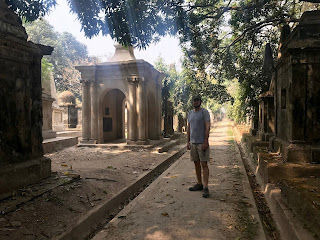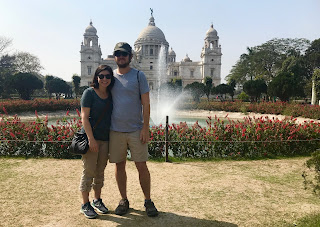Leaving India on a High Note: Two Days in Kolkata
Matt and
I bid farewell to India very early on the morning of February 23rd after
almost four weeks of travel through the diverse and vibrant country. At the
time of writing this post, we were en route to Myanmar, where we will spend the
next two weeks! Our final Indian hurrah was two full days in Kolkata, the capital of the northeastern
state of West Bengal. Kolkata was the capital of the British-held Indian
territories until 1911 before Delhi was designated as the new site. Known as
the cultural hub of India for its literary and artistic influence on the
country, Kolkata is the location of Mother Teresa’s Missionaries of Charity, an
organization she founded to serve the poor, sick, and orphaned. Mother Teresa
later won a Nobel Prize for her work in Kolkata and around the world. Despite
this interesting history, few friends or acquaintances had actually visited the
city and some recommended that we skip out on it altogether. Perhaps this was
because of Kolkata’s mid-20th century economic stagnation and
intense refugee challenges over the past few decades, from which the city has
yet to fully recover. Regardless, we ended our India tour here, unsure what to
expect and excited to experience yet another region within the large country!
Kolkata
pleasantly surprised us from the moment we arrived. Our AirAsia flight landed at
10:30pm and we picked up an Uber from the airport, eager to get in the car as biting
mosquitos were rampant outside. During the late-night ride we passed dozens of
impressive high-rise apartment buildings, hotels, and company headquarters
lining the highway. Our AirBnB
was located in a gated complex near Kolkata’s popular Park Street, a
neighborhood with glitzy shops and hip restaurants; I had read that this was
the best place to stay in the city. The unit’s full-time caretaker escorted us
to our room, and in the morning, we met the four Tibetan monks who were sharing
our apartment; they were spending five months in Kolkata to learn English and
were very friendly albeit “messy”—as the AirBnB host had warned me about prior
to our arrival. Matt even showed off the picture of me with the Dalai Lama that
was taken when the spiritual leader visited William & Mary in 2012, and the
monks seemed impressed!
After a
homemade breakfast we set out on foot to explore the city (our favorite way to
travel!), relying on Lonely Planet’s recommended itineraries and selecting the
best options. Sidewalks were relatively well-defined and usually separated completely
from the street, which made for an easier urban tour than in other Indian cities
we had visited. We began at the South Park
Street Cemetery, a jungle-like oasis from the busy city with massive
memorial structures for people who had died in the past few centuries. We
weaved through rows of mausoleums that seemed Roman-inspired in their design,
many shaped like obelisks or columned gazebos. We read the grave markings and
unsurprisingly quite a few of those buried in the cemetery had died very young.
Most were Englishmen and women working for the East India Trading Company. Next
stop: St.
Paul’s Cathedral, the first British church established in any of its
colonies. The gothic-style exterior was complemented by colorful gardens
surrounding the perimeter, and the inside was huge! A mass could easily host
two hundred patrons.
Wandering through South Park Street Cemetery in Kolkata.
Outside St. Paul's Cathedral in Kolkata.
We
proceeded to visit Kolkata’s #1 tourist attraction, the Victoria
Memorial. Built to honor Queen Victoria after her death in 1901, the
beautiful, white-marble building looks like a cross between the US Capitol and
the Taj Mahal. It is surrounded by 64 acres
of brightly landscaped gardens and fountains; many locals were hanging out
around the memorial enjoying picnics with family and friends. We strolled the
gardens for a half-hour before entering the Memorial itself, which housed an
art gallery featuring paintings of India, a historical exhibit about the
history of Kolkata, and many artifacts from Queen Victoria’s life including the
grand piano on which she learned to play music as a child. In the center of the
main domed hall was a large statue of Queen Victoria, and 12 paintings
depicting her birth, life, and death circled the curved ceiling. We were able
to walk around the balcony on the second floor to get a closer look at the
stunning paintings which shone with gold accents. The Lonely Planet guidebook pointed
out that if the memorial had been built for an Indian princess instead of a British
Queen, it would likely be one of the most touted structures in the country.
Matt and I felt lucky to be able to see it, considering we hadn’t known about
the memorial prior to our arrival in Kolkata!
Outside the Victoria Memorial.
Walking through the 64-acre gardens of the Victoria Memorial.
Exhausted
from a day in the heat (despite this being India’s cool season) and stuffed to
the brim with kebabs from Peter
Cat restaurant, we wrapped up with a speed-walk through the not-so-lovely-smelling
New Market, passing chickens stuffed in coops and dozens of textile vendors to
pick up a chocolate pastry at Nahoum
and Son’s Jewish Bakery. The bakery was founded in 1902 and sells all the
staples: challah, babka, plum cakes, and more. The store manager was very proud
of the bakery’s history, pointing out pictures of the founder and his sons that
hang in old wooden frames on the wall. That evening Matt and I relaxed, read
books, applied for jobs, and ordered chaat and chana masala for dinner using
the delivery app, Swiggy, which is exactly like Uber Eats but much cheaper! We ate
the tasty meal as we finished the premiere season of Russian Doll on Netflix, a
dark comedy series reminiscent of the movie Groundhog Day.
We arose
early the next morning to see another famous Kolkata landmark, the Missionaries of
Charity’s Mother House, formed by Mother Teresa in 1950 to give “wholehearted
free service to the poorest of the poor.” The organization has since expanded,
and in 2012 4,500 nuns worked for the organization. It has focused on refugees,
orphaned children, lepers, people with AIDS, and more since its founding. The active
religious and historic site is located off a nondescript alley which was about
a 15-minute walk from our AirBnB. We walked through a small museum stocked with
all Mother Teresa’s speeches and personal belongings like her brown leather
sandals, pencil case, photographs, and correspondence. The museum featured
informational panels detailing Mother Teresa’s life and charity work as well.
She committed herself to living very simply, and we were able to walk up a steep
flight of stairs to see her room above the facility’s kitchen, which housed just
a twin-sized bed, wooden desk, and a few pictures with the pope. Apparently the
room became incredibly hot with its location over the kitchen, but she refused
to even use a fan to cool it down. We also saw her tomb, around which many visitors
were praying. It was a moving experience, and Matt and I left the site
discussing Mother Teresa’s life and how meaningful it was that she “walked the
walk” as well as “talked the talk”; she committed herself to the poor and lived
a simple life rather than an extravagant one like many modern, internationally-recognized
leaders in relief work. We also discussed the various criticisms of Mother
Teresa including her views on birth control, which were alluded to in the
museum but of course not explicitly discuss in detail.
With a statue of Mother Teresa at Mother House in Kolkata.
We
breezed through an open-air flower market on our way to Kolkata’s three synagogues,
which were true highlights for me and listed as must-sees in our guidebook. As
I mentioned in my Kerala post, India has an interesting Jewish history. In
Kolkata, the Jewish community was initially comprised of Baghdadi refugees
and their offspring, reaching a peak of 6,000 people but shrinking to the
current 100 Kolkata Jews after many emigrated to Israel after its founding.
Despite this small modern population, three synagogues in Kolkata are
well-maintained within a four-block radius of each other including the Magen
David Synagogue (1884), Beth El Synagogue (1856), and the Neveh Shalom Synagogue
(1825). Each featured beautiful stained glass, colorful interiors, a bimah in front, and a podium for a rabbi
in the middle of the room—distinguishing them from the synagogues I grew up in.
Security guards at each location would ask me and Matt: “Are you Jewish?” before
letting us into the buildings, which were all hidden away behind steel gates
and not open to the public. We signed guestbooks upon entering each temple and
Matt was handed a kippah to wear as we walked around inside. There are no
rabbis on-site, and only one congregant attends for weekly Shabbat while 10
attend for Rosh Hashanah and Yom Kippur. The buildings are maintained by a
Kolkata Jewish Trust and Matt and I also assumed a bit of money from the Indian
government helps to sustain the historic buildings.
About to enter the Magen David Synagogue.
On the upper level of the Magen David Synagogue.
The Beth El Synagogue was very colorful!








What a great opportunity to learn more about Mother Theresa! It sounds like the last days in India were good ones. Onward Myanmar!
ReplyDelete